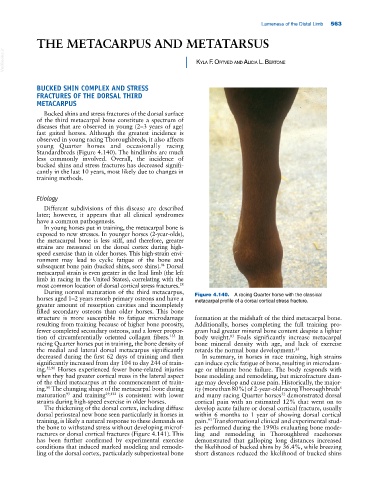Page 597 - Adams and Stashak's Lameness in Horses, 7th Edition
P. 597
Lameness of the Distal Limb 563
THE METACARPUS AND METATARSUS
VetBooks.ir kyla F. oRtvEd and alicia l. BERtonE
BUCKED SHIN COMPLEX AND STRESS
FRACTURES OF THE DORSAL THIRD
METACARPUS
Bucked shins and stress fractures of the dorsal surface
of the third metacarpal bone constitute a spectrum of
diseases that are observed in young (2–3 years of age)
fast gaited horses. Although the greatest incidence is
observed in young racing Thoroughbreds, it also affects
young Quarter horses and occasionally racing
Standardbreds (Figure 4.140). The hindlimbs are much
less commonly involved. Overall, the incidence of
bucked shins and stress fractures has decreased signifi-
cantly in the last 10 years, most likely due to changes in
training methods.
Etiology
Different subdivisions of this disease are described
later; however, it appears that all clinical syndromes
have a common pathogenesis.
In young horses put in training, the metacarpal bone is
exposed to new stresses. In younger horses (2‐year‐olds),
the metacarpal bone is less stiff, and therefore, greater
strains are measured on the dorsal cortex during high‐
speed exercise than in older horses. This high‐strain envi-
ronment may lead to cyclic fatigue of the bone and
94
subsequent bone pain (bucked shins, sore shins). Dorsal
metacarpal strain is even greater in the lead limb (the left
limb in racing in the United States), correlating with the
most common location of dorsal cortical stress fractures. 28
During normal maturation of the third metacarpus, Figure 4.140. A racing Quarter horse with the classical
horses aged 1–2 years resorb primary osteons and have a metacarpal profile of a dorsal cortical stress fracture.
greater amount of resorption cavities and incompletely
filled secondary osteons than older horses. This bone
structure is more susceptible to fatigue microdamage formation at the midshaft of the third metacarpal bone.
resulting from training because of higher bone porosity, Additionally, horses completing the full training pro-
fewer completed secondary osteons, and a lower propor- gram had greater mineral bone content despite a lighter
tion of circumferentially oriented collagen fibers. In body weight. Foals significantly increase metacarpal
83
133
racing Quarter horses put in training, the bone density of bone mineral density with age, and lack of exercise
the medial and lateral dorsal metacarpus significantly retards the normal bone development. 25
decreased during the first 62 days of training and then In summary, in horses in race training, high strains
significantly increased from day 104 to day 244 of train- can induce cyclic fatigue of bone, resulting in microdam-
ing. 52,90 Horses experienced fewer bone‐related injuries age or ultimate bone failure. The body responds with
when they had greater cortical mass in the lateral aspect bone modeling and remodeling, but microfracture dam-
of the third metacarpus at the commencement of train- age may develop and cause pain. Historically, the major-
ing. The changing shape of the metacarpal bone during ity (more than 80%) of 2‐year‐old racing Thoroughbreds
6
90
maturation and training 29,122 is consistent with lower and many racing Quarter horses demonstrated dorsal
93
52
strains during high‐speed exercise in older horses. cortical pain with an estimated 12% that went on to
The thickening of the dorsal cortex, including diffuse develop acute failure or dorsal cortical fracture, usually
dorsal periosteal new bone seen particularly in horses in within 6 months to 1 year of showing dorsal cortical
training, is likely a natural response to these demands on pain. Transformational clinical and experimental stud-
93
the bone to withstand stress without developing microf- ies performed during the 1990s evaluating bone mode-
ractures or dorsal cortical fractures (Figure 4.141). This ling and remodeling in Thoroughbred racehorses
has been further confirmed by experimental exercise demonstrated that galloping long distances increased
conditions that induced marked modeling and remode- the likelihood of bucked shins by 36.4%, while breezing
ling of the dorsal cortex, particularly subperiosteal bone short distances reduced the likelihood of bucked shins

